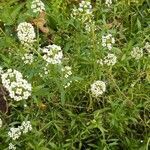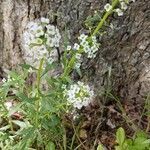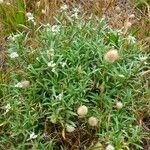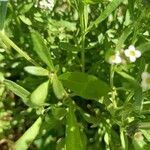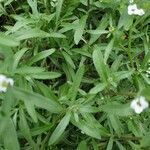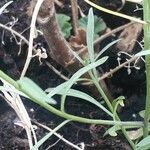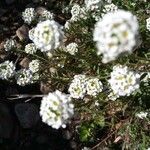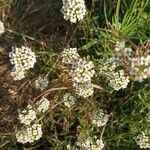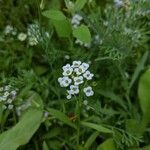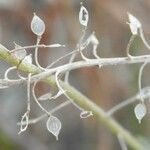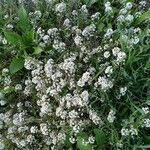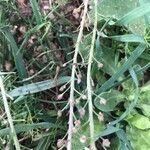Plants suffruticose (when subshrubs). Stems 0.5-2.5(-4) dm. Leaves: blade linear or lanceolate-oblanceolate, (1-)1.6-2.5(-4.2) cm × (1-)2-3(-7) mm, base attenuate, apex acute. Racemes elongated in fruit, (1-)4-8(-16) cm, (dense). Fruiting pedicels (3-)4.5-6(-9.5) mm. Flowers: sepals often tinged purplish, (1.4-)1.5-1.7 (-2.4) mm; petals broadly obovate, (1.9-)2.3-2.8(-3.1) × (1.2-)1.6-2(-2.6) mm, abruptly contracted into claw; filaments 1.2-2 mm; anthers 0.3-0.5 mm. Fruits (1.9-) 2.3-2.7(-4.2) × (1.2-)1.6-2(-2.9) mm; valve margins thin, sparsely pubescent; style 0.4-0.6 mm. Seeds light to reddish brown, not winged, (1-)1.2-1.4(-2) × (0.7-) 1-1.1(-1.6) mm. 2n = 24.
Usually perennial, rarely annual. Stems decumbent to ascending, hairy, leafy, branched below, 10-30-(45) cm tall. Lvs entire, hairy, linear-lanceolate to lanceolate, subacute, 12-30 × 2-3-(4) mm. Racemes 4-15 cm long; fls crowded in globose heads; pedicels spreading, hairy, 6-7 mm long. Sepals hairy, 1.5-2 × 0.5-0.8 mm. Petals glabrous, entire, usually white, rarely purple, 2.5-3 × 1.5-2 mm. Silicle obovate, subacute, slightly inflated, 3-4 × 1.5-2.5 mm; valves membranous, glabrous or sparsely hairy. Style c. 0.6 mm long. Seeds brown, ovoid, compressed, very narrowly winged, c. 1.2 × 1 mm, 1 per locule.
A cabbage family herb. It can re-grow from seed each year or keep growing for a few years. It is about 8-15 cm tall and 20-30 cm wide. It branches freely producing a bushy plant. The leaves are narrowly sword shaped and 1.5-5 cm long. They are entire and taper to the base and the tip. They are greyish and hairy. The flowers are small and clustered at the ends of stems. The flowers are fragrant. The flowers have 4 petals arranged in a cross shape. They can be pink, purple or white. The flowering shoot lengthens as the fruit develop. The pod is 2.5-3.5 mm wide. There is one seed per section.
Annual or perennial herbs, erect or procumbent, branching from the base, 10-30 cm high; stems, leaves, pedicels, sepals and ovaries strigose with appressed medifixed hairs, glabrescent, the silicules eventually glabrous. Leaves linear-lanceolate, acute, entire, 2-4 cm x 2-4 mm. Racemes many-flowered, lax in fruit. Pedicels spreading ± horizontally with the fruits erect. Petals 3-3.5 mm long, blade circular, clawed. Siliculae 2.5-3.5 mm long, broadly elliptic to obovate; seeds solitary in each cell; style 0.5 mm long, slender.
Annual, occasionally perennial herb, 0.1-0.3 m high, erect or procumbent, branching from base; stems, leaves, pedicels, sepals and ovaries strigose with appressed medifixed hairs, glabrescent, siliqua eventually glabrous. Leaves linear-lanceolate, acute, margins entire. Inflorescence a many-flowered raceme, lax in fruit. Pedicels spreading horizontally with the fruits erect. Petals clawed, circular. Fruit a siliqua, broadly elliptic to obovate. Seeds solitary in each cell.
Perennial herb 5–40 cm high, ascending, hairy with simple or medifixed hairs. Leaves linear to linear-lanceolate, 2–4 cm long, almost entire, subsessile. Flowers in clusters, small, sweetly scented. Petals 2.5–4 mm long, white, pink or purple. Stamens 6. Style c. 0.5 mm long, slender, prominent. Silicula obovate to almost orbicular, 2–4 mm wide, compressed; valves convex, hairy. Seed oval, c. 1.5 mm long, compressed, narrowly winged.
Lax, diffusely branched annual to perennial, 1–3 dm, finely strigose; lvs linear to linear-oblanceolate, 2–5 cm, acute; fls fragrant, 4 mm wide; fr flattened with convex sides, elliptic, 3 × 2 mm, very sparsely hairy; ovules 1 per locule; 2n=22, 24. Native of s. Europe, often escaped from cult. in our range. All summer. (Koniga m.)
